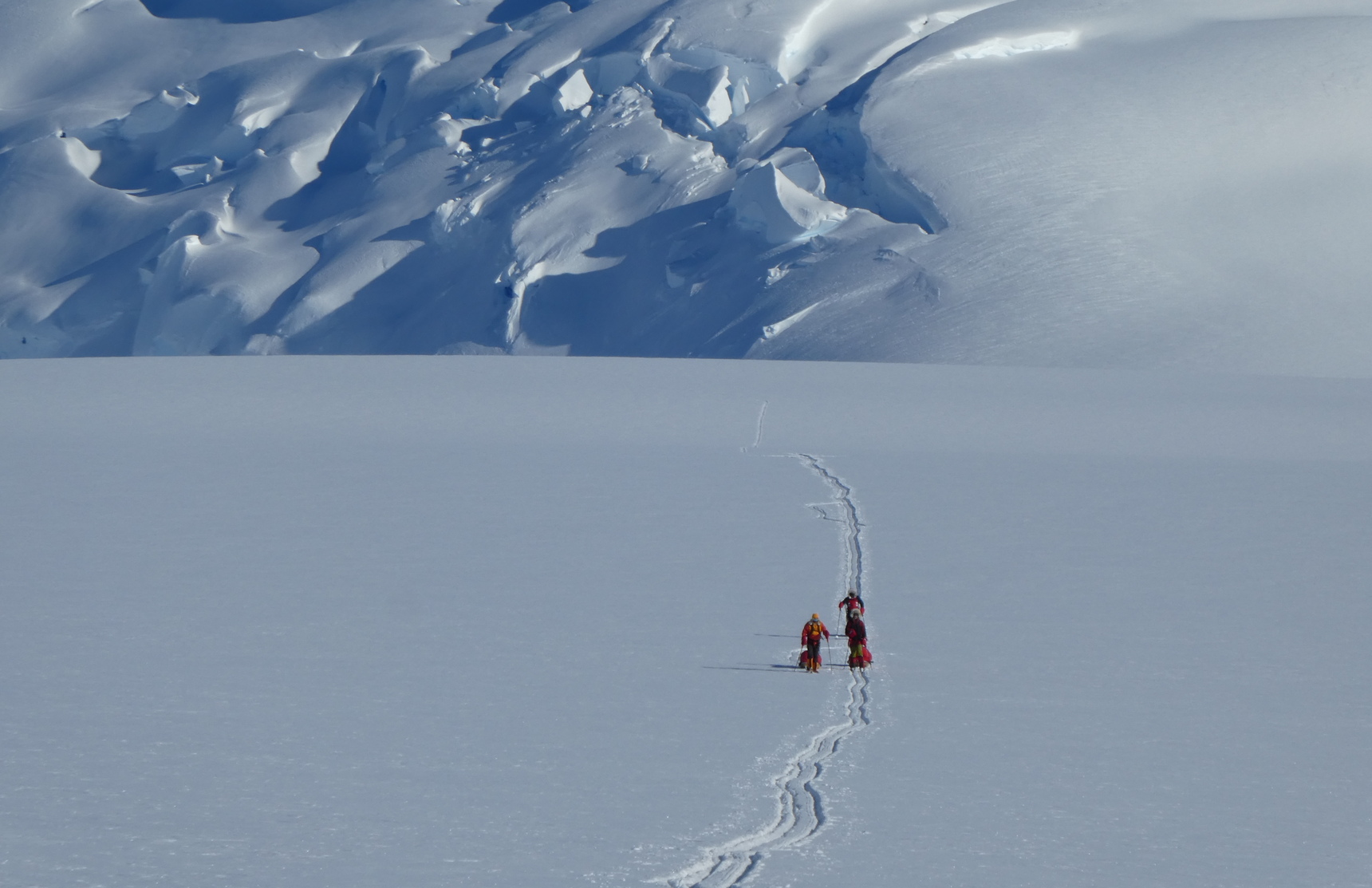The 2021 Antarctic season was one of the most challenging in ALE’s history, with an ongoing pandemic, disparate and changing travel regulations, and incredibly challenging Antarctic weather conditions. Despite this, an intrepid group of Antarctic expeditions set their sights on the South Pole and beyond. Here is a round-up of the 2021 season expeditions.
The Teams and the Routes
The COVID-19 pandemic had impacts on expeditions long before the season started. Travel bans prevented many teams from doing their planned polar training, while others were unable to meet fund-raising targets or find sponsorships due to the financial impacts of the pandemic. In the run up to the season, the uncertainties surrounding travel to Chile and general difficulties caused by the coronavirus prompted other teams to postpone for a year. As such, it was a small but determined band of expeditioners who made it to Punta Arenas to embark on their expeditions.
Four expeditions set off from West Antarctica starting points around the Ronne-Filchner Ice Shelf. Three of them started from Hercules Inlet and one from Berkner Island. For the first time in 10 years, no expeditions attempted the The Messner Start route to the South Pole.
Two expeditions set off from starting points on the Ross Ice Shelf. There was also one snow-kiting expedition starting in Dronning Maud Land and finishing at Union Glacier.
Ski South Pole – Hercules Inlet
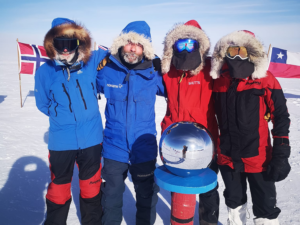
Ski South Pole Hercules Inlet team at the South Pole. Photo: Are Johansen
The most popular expedition starting point continues to be Hercules Inlet on the Ronne Ice Shelf. From here it is 1,126 km to the South Pole and this takes an average of 53 days.
ALE Ski South Pole Hercules Inlet
The ALE-guided expedition included an all-British team of participants: Mark Cadman and father and daughter team, Mark and Leanna Shuttleworth. The team were ably guided by Are Johansen (NOR), when the original guide fell ill and was unable to undertake the expedition. We were very fortunate that Are could come at short notice, as South Pole expedition guides with the experience, availability and fitness to lead an expedition without months of dedicated fitness training are few and far between. Another very experienced guide, Rob Smith, helped the team finish their all-important rations packing in Punta Arenas and skied with them until Are arrived in Antarctica to join the group. The expedition skied through three planned resupplies and reached the South Pole in 56 days on January 19. Mark and Leanna became the third parent-daughter (or son) team to ski to the South Pole.

Adaptive Grand Slam
The Adaptive Grand Slam team consisted of British Army veterans Martin Hewitt and Louis Rudd. Martin was wounded in Afghanistan and has gone on to run the Adaptive Grand Slam organization, tackling expeditions to both North and South Poles and the Seven Summits, for and with wounded British Army veterans. In recent years, people have only been able to do the Last Degree version of the Grand Slam due to logistic constraints around North Pole expeditions. Despite this, Martin chose to take on the much longer Hercules Inlet route to the South Pole. Disastrously he strained an achilles tendon and after a courageous struggle, he and Louis were picked up from the halfway point and flown south to 89°S. From there they were able to ski the Last Degree that Martin needed for his Grand Slam. They then flew to Mount Vinson and climbed that to finish the challenge.
Preet Chandi
Preet Chandi’s story has been widely told, particularly in British and Indian media since she came home. She is a Captain in the British Army and made the journey from polar novice to capable expedition soloist, after training in Norway, Iceland, and the Alps. She was one of the only people to have got to Greenland in 2021 for final polar training. She skied solo and unsupported from Hercules Inlet to the South Pole in good style and plans to return to Antarctica for a longer solo crossing.
Ski South Pole – Berkner Island
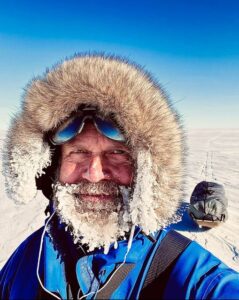 The Berkner Island route is longer, remoter, and more costly to resupply than the Hercules Inlet or Messner Start routes. It suits teams who are happy to ski that distance on an unsupported journey. From the northern end of Berkner Island the route drops down to the Filchner Ice Shelf, then ascends steeply toward the Sallee Snowfield between the Dufek Massif and the Forrestal Mountain range. After this the landscape becomes bleaker, as the mountains drop below the horizon and skiers are faced with hundreds of kilometers of wind-blown snowscape and sastrugi.
The Berkner Island route is longer, remoter, and more costly to resupply than the Hercules Inlet or Messner Start routes. It suits teams who are happy to ski that distance on an unsupported journey. From the northern end of Berkner Island the route drops down to the Filchner Ice Shelf, then ascends steeply toward the Sallee Snowfield between the Dufek Massif and the Forrestal Mountain range. After this the landscape becomes bleaker, as the mountains drop below the horizon and skiers are faced with hundreds of kilometers of wind-blown snowscape and sastrugi.
In the 1990s expeditions wanted to start from around 78˚South on Berkner Island, as that was as far south as it might be possible to get by ship. These days ALE has an aircraft landing site close to the north coast of the island and the advent of the Polar Expedition Classification System (www.pec-s.com) codified an outer coastal starting zone which is about 10 km north of the aircraft landing site.
Erik Larssen
Ousland Explorations in Norway helped Erik Larssen prepare for his solo ski expedition from the northern end of Berkner Island to the South Pole. Erik was the first expedition to make the additional round trip to log a starting point in the outer coastal zone, and it seems likely that this will become the norm for future expeditions. He logged a total distance from this starting point of 1,368 km compared to 1,349 km from the aircraft landing strip to the South Pole. Erik reached the South Pole successfully after 59 days.
Ski South Pole – Axel Heiberg
The Axel Heiberg Glacier is an extremely challenging and committing route to the South Pole. The route climbs steeply through deep soft snow, then winds its way through crevasses and a series of terraces and ice falls, before arriving on the upper glacier and the plateau. In contrast to the micro-climate of the lower glacier, the upper glacier is often very windy with extremely cold temperatures.
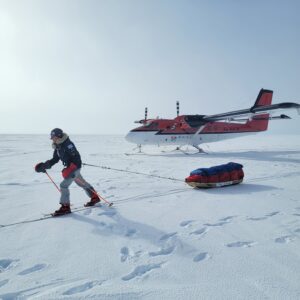 The distance from Union Glacier combined with the difficulties of providing air support anywhere on the glacier mean that this is always a challenging and committing route. The adverse weather this season added to the already considerable difficulties and it repelled all comers.
The distance from Union Glacier combined with the difficulties of providing air support anywhere on the glacier mean that this is always a challenging and committing route. The adverse weather this season added to the already considerable difficulties and it repelled all comers.
Mastatsu Abe
This was Masatatsu Abe’s second expedition to Antarctica. In 2018 he undertook a solo training expedition on The Messner Start route and this year returned to undertake a longer expedition from the Ross Ice Shelf to the South Pole. Abe was inspired by Lt. Nobu Shirase’s 1910-12 expedition, which put a team ashore at Bay of Whales to make a southwards journey using dogs. Their ‘Dash Patrol’ reached a furthest south called Yamato-yukihara at 80°05’S 156°37’W and this was Masatatsu Abe’s starting point. It is well to the east of the direct route south from the Bay of Whales and it took far longer than hoped to get across the ice shelf. By the time he had reached the base of the Axel Heiberg Glacier there was not sufficient time left to reach the South Pole. After a reconnaissance foray onto the lower section of the glacier, Abe turned around and retraced his steps to the aircraft landing site close to the bottom of the glacier. He is already planning to return.
ALE Ski South Pole Axel Heiberg
The ALE guided Axel Heiberg expedition started at the base of the Axel Heiberg Glacier. On the lower glacier, the snow was knee deep forcing the teamto shuttle their loads. On the upper glacier, strong winds and blowing snow reduced the visibility that is vital for navigating the technically challenging route. The team was pinned down by winds up to 55 knots for most of five days. Then, after only two days of skiing, another severe storm pinned them down for a week, leaving the team short of food, behind schedule, and exhausted from lack of sleep. Finally, on Christmas Day the weather improved. This provided a much-needed day to recover and the opportunity to airlift the team three degrees to 89˚South. From there, the group completed the Last Degree to the South Pole in six days.
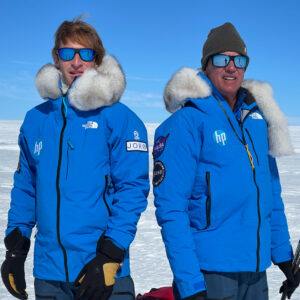
Snow Kiting – Dronning Maud Land – South Pole – Union Glacier
Chasing the Light
Chasing The Light was the only snow-kiting expedition this season. The two-man British team consisted of Justin Packshaw and Jamie Facer-Childs, both veterans of sled-hauling expeditions. They hoped to repeat the 4,000 km snow-kiting route from Novolazarevskaya via one of the Poles of Inaccessibility and the South Pole to Union Glacier, which had been done by Sebastian Copeland & Eric McNair-Landry in 2011, and solo by Frédéric Dion in 2014. They fell behind schedule and made the pragmatic decision to go straight to the South Pole, missing out the long dog-leg to see Lenin’s bust at the old Soviet station Polyus Nedostupnosti. They also had a program of physiology research planned with Stanford University. After 58 days they reached South Pole and stopped there.
Looking forward to 2022
Adverse weather played a part in the success or otherwise of several teams this season and it will be interesting to see if these are signs of changes to worldwide climate systems. The Axel Heiberg Glacier repelled all comers this season. For expeditions wanting to experience the isolation and commitment of a glacier route through the Transantarctic Mountains, there are other alternatives and perhaps we will see more expeditions explore some of these in the coming seasons?
After a small expedition season in 2021 it is likely that the next couple of seasons will be much busier as teams are able to train again and to revisit their fundraising plans. I can’t wait.
Steve Jones – ALE Expedition Manager
Photos Credits:
Header image: Skiers ascending the Axel Heiberg Glacier – Rob Smith.
Inset images: Ski South Pole Hercules Inlet team at the South Pole – Are Johansen; Martin Hewitt and Louis Rudd at Union Glacier after their expedition – Adaptive Grand Slam; Erik Bertrand Larssen, self-image; Masatatsu Abe setting off on his South Pole expedition – Russ Hepburn; Chasing the Light team – Justin Packshaw


